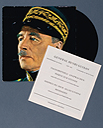
 |
Switzerland Mercifully Fit to Fight In the first two decades after 1945 the collective memory of Switzerland was dominated by images of the readiness to defend. General Guisan played an especially important role. Alongside this image was that of the "merciful Switzerland" as a counterbalance to the military-political non-engagement of the neutral country. This allowed the twofold imagery, already during the War, to fuse together: the identity of "readiness to defend" and "mercifulness". "Merciful Switzerland" was and is documented by the military internees, the border inhabitants and the holiday children. However, there are few images of victims of Nazi persecution who sought refuge for political or "racist" reasons. The prevailing idea was that one was forced to be cruel to those in need of protection due to the adversities of the prevailing conditions. Federal Councillor Eduard von Steiger, the person in charge of refugee policy, did not dispute that his policy was cruel. To justify the closing of the border he coined the image of the lifeboat and declared on 30 August 1942: "Anyone who is in command of an already heavily laden little lifeboat with limited capacity and equally limited supplies, while thousands of victims of a ship's catastrophe are crying for help, must appear hard-hearted when he doesn't take all of them in." |
| General Henri Guisan stands for the Swiss readiness to defend the country. His portraits, which hung everywhere during the War, simply remained hanging in their prominent places (offices, police prefectures, pubs) after the War. They gradually began to disappear in the 1970s – only to reappear in second-hand shops and flea markets. In the 1960s his "Words of the Hour" were given to the public in the form of a phonograph record. | |
| The refugee question was first treated in the film "The Last Chance" from 1944/45. A group of refugees managed by supreme effort to cross the mountains from Italy into Switzerland in the fall of 1943 and, after anxious moments of waiting, were finally taken in – a story with a happy end. In order to get permission to shoot the film, the producer had to promise Federal Counsellor Eduard von Steiger that the film would be in the interests of Switzerland abroad. The federal government wanted the "visionize" the film before allowing it to be released because it was feared that the image of “merciful Switzerland” could be harmed. At the approval screening Federal Counsellor von Steiger criticized that the film set a bureaucratic officer opposite the sympathetic refugees and that it represented Swiss medicine in a bad light. Various motifs from the film are combined on the poster. The poster focuses on the helpers, of whom only two will survive, and the refugees being pursued before the magnificent setting of the snow-bound mountains, shortly before reaching the redeeming Swiss border. |
|





